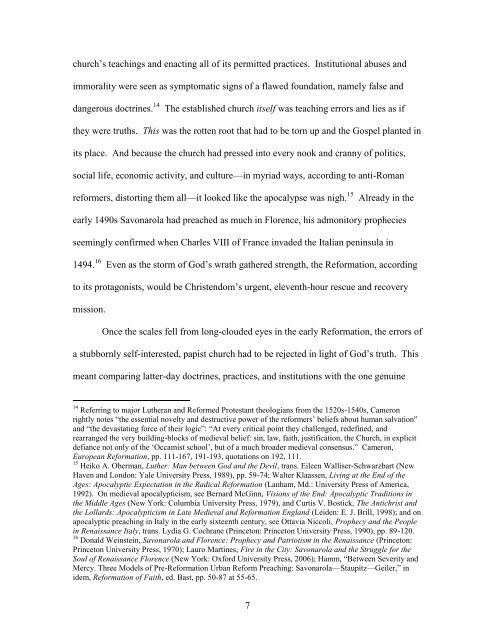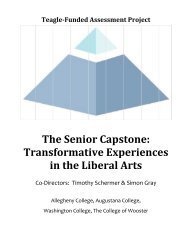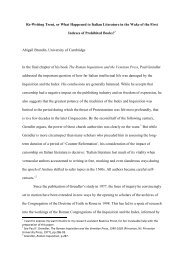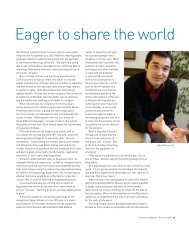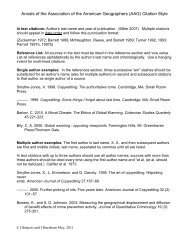Brad S. Gregory - Augustana College
Brad S. Gregory - Augustana College
Brad S. Gregory - Augustana College
Create successful ePaper yourself
Turn your PDF publications into a flip-book with our unique Google optimized e-Paper software.
church‟s teachings and enacting all of its permitted practices. Institutional abuses and<br />
immorality were seen as symptomatic signs of a flawed foundation, namely false and<br />
dangerous doctrines. 14 The established church itself was teaching errors and lies as if<br />
they were truths. This was the rotten root that had to be torn up and the Gospel planted in<br />
its place. And because the church had pressed into every nook and cranny of politics,<br />
social life, economic activity, and culture—in myriad ways, according to anti-Roman<br />
reformers, distorting them all—it looked like the apocalypse was nigh. 15 Already in the<br />
early 1490s Savonarola had preached as much in Florence, his admonitory prophecies<br />
seemingly confirmed when Charles VIII of France invaded the Italian peninsula in<br />
1494. 16 Even as the storm of God‟s wrath gathered strength, the Reformation, according<br />
to its protagonists, would be Christendom‟s urgent, eleventh-hour rescue and recovery<br />
mission.<br />
Once the scales fell from long-clouded eyes in the early Reformation, the errors of<br />
a stubbornly self-interested, papist church had to be rejected in light of God‟s truth. This<br />
meant comparing latter-day doctrines, practices, and institutions with the one genuine<br />
14 Referring to major Lutheran and Reformed Protestant theologians from the 1520s-1540s, Cameron<br />
rightly notes “the essential novelty and destructive power of the reformers‟ beliefs about human salvation”<br />
and “the devastating force of their logic”: “At every critical point they challenged, redefined, and<br />
rearranged the very building-blocks of medieval belief: sin, law, faith, justification, the Church, in explicit<br />
defiance not only of the „Occamist school‟, but of a much broader medieval consensus.” Cameron,<br />
European Reformation, pp. 111-167, 191-193, quotations on 192, 111.<br />
15 Heiko A. Oberman, Luther: Man between God and the Devil, trans. Eileen Walliser-Schwarzbart (New<br />
Haven and London: Yale University Press, 1989), pp. 59-74; Walter Klaassen, Living at the End of the<br />
Ages: Apocalyptic Expectation in the Radical Reformation (Lanham, Md.: University Press of America,<br />
1992). On medieval apocalypticism, see Bernard McGinn, Visions of the End: Apocalyptic Traditions in<br />
the Middle Ages (New York: Columbia University Press, 1979), and Curtis V. Bostick, The Antichrist and<br />
the Lollards: Apocalypticism in Late Medieval and Reformation England (Leiden: E. J. Brill, 1998); and on<br />
apocalyptic preaching in Italy in the early sixteenth century, see Ottavia Niccoli, Prophecy and the People<br />
in Renaissance Italy, trans. Lydia G. Cochrane (Princeton: Princeton University Press, 1990), pp. 89-120.<br />
16 Donald Weinstein, Savonarola and Florence: Prophecy and Patriotism in the Renaissance (Princeton:<br />
Princeton University Press, 1970); Lauro Martines, Fire in the City: Savonarola and the Struggle for the<br />
Soul of Renaissance Florence (New York: Oxford University Press, 2006); Hamm, “Between Severity and<br />
Mercy. Three Models of Pre-Reformation Urban Reform Preaching: Savonarola—Staupitz—Geiler,” in<br />
idem, Reformation of Faith, ed. Bast, pp. 50-87 at 55-65.<br />
7


